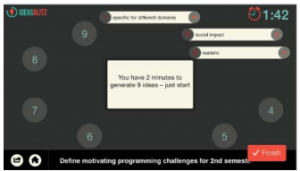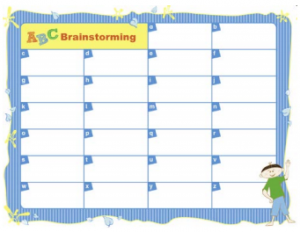Idea Quota/OG
| Idea Quota | |
| Contributors | Christian Kohls |
|---|---|
| Last modification | May 17, 2017 |
| Source | Kohls (2014)[1]; Kohls (2015)[2] |
| Pattern formats | OPR Alexandrian |
| Usability | |
| Learning domain | |
| Stakeholders | |
Don’t be satisfied with the obvious ideas. Dig deeper.
Context
It is easy to come up with some ideas using Brainstorming, Idea Combination, Provocations, or any of the other techniques described in this pattern language. But the ideas that come into mind at first very often are the obvious solutions or copies of existing approaches. These are hardly the ones that lead to innovation.
Problem
We are tempted to stop searching for new ideas too early. There is a tendency to be satisfied by a couple of good ideas. But the less obvious solutions are more likely to be the creative ones – ideas that have not been discovered yet. To find these ideas you have to dig deeper.
Forces
Ideas come in waves. That is we will first find what is already in our mind. Then we need some time to think about further ideas. Then, a second wave of ideas will spread out of our minds. However, the time between these two (or more) waves is often misunderstood as a signal that no more good ideas will come into our minds. If we don’t come up with more ideas we think that the range of possible solutions is exhausted. But that is not true for there is always an infinite number of possible solution forms. It is just that we need to think harder for more ideas.
Very often meetings are under time pressure. And waiting for new ideas while one has already collected some ideas might be considered as a waste of time. The true waste of time, however, is the implementation of a weak idea.
Sometimes we need a little push to try harder. Sport trainers are very good at pushing us beyond our own perceived limits. When we look for the best ideas we also need a push to exceed our limits.
An idea can only be judged when compared to other ideas. The more alternatives you have the better your choice can be.
Solution
Therefore, set yourself an idea quota. An idea quota is the minimum number of ideas you want to find. The idea quota can be used for single creativity sessions or on-going projects, it can be used individually or for groups.
- Set the quota to a specific minimum number.
- Specify a time frame in which the number should be reached.
- Use Thought Triggers to generate more and more ideas
- Build on existing ideas you have already found and modify or combine them into new ideas.
- Once the quota is reached, review the ideas and pick the most promising one and continue to work on them.
Example
Five examples for idea quotas:
- Find at least 100 ideas.
- Find 5 ideas in 5 minutes.
- Find 1 idea every while on your way to work.
- Find 1 idea for each letter of the alphabet.
- Each group has to find 10 ideas.
Supporting Tools
Consequences
Instead of waiting for the next idea to occur by accident, an idea quota forces you to generate more and more ideas, think about alternatives, recombine existing ideas etc.[3] If there is a requirement to come up with a minimum number of ideas, it is more likely that you express every thought – even the strange or unconventional ideas. As it happens there is a good chance that the best idea is among those curious solutions. Yes, it’s true: if you write down every ridiculous idea then most of the ideas will be just that – ridiculous thoughts. But to sort out the good ones should be saved for later. Once you generated hundreds of ideas there is a better chance that one of these ideas is brilliant. In order to generate this high number of ideas you should Suspend Judgment.
Thomas Edison aimed at small inventions every ten days and for large inventions every six months[3]. If you are a writer, you should produce texts every day – and keep the good ones. If you are a project manager, think about two process optimizations every day. If you are a software developer think about five new features every day. If you want to improve your personal life, sit down seven days a week and make a list of seven potential improvements every day. Now, here is my challenge for you: Think about ten things in your work life that could benefit from a daily idea quota. You have five minutes.
References
- ↑ Patlet published in Kohls, C. (2014). Dream teams at the right place. In Proceedings of the 19th European Conference on Pattern Languages of Programs (EuroPLoP 2014) (p. 3). New York:ACM.
- ↑ Pattern published in Kohls, C. (2015). Patterns for creative thinking: idea generation. In Proceedings of the 20th European Conference on Pattern Languages of Programs (EuroPLoP 2015) (p. 30). New York:ACM.
- ↑ 3.0 3.1 Michalko, M. (2006). Thinkertoys: A handbook of creative-thinking techniques. Berkeley, Calif: Ten Speed.


